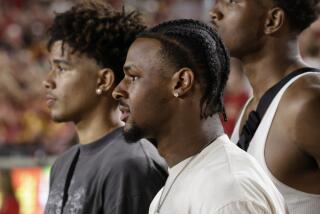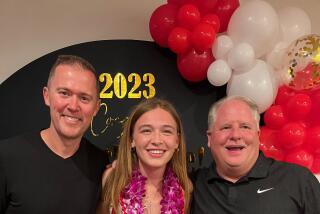Doctor: Gathers Left Court Alive : Jurisprudence: Shaffer testifies that Loyola player was moved for treatment because he had good pulse and was breathing.
- Share via
The doctor who made the decision to move Hank Gathers rather than treat him on the basketball court where he collapsed said he did so because Gathers had a good pulse, was breathing and was responsive to his commands.
Ben Shaffer, an orthopedist who was the doctor on duty at Loyola Marymount University on March 4, 1990, the night Gathers collapsed while playing in a basketball game and later died, testified in Superior Court in Torrance on Wednesday that Gathers’ condition did not deteriorate until he was on a stretcher.
“As we lifted him on the stretcher, he was breathing and responsive to my commands, and we proceeded to what we thought would be the training room,” said Shaffer, who is one of two doctors being sued by the Gathers family for negligence in how they treated Gathers the night he died.
“As we neared the corner (to turn toward the training room), he (Gathers) appeared to me to have clinically deteriorated and we sat him down outside the exit door.”
Shaffer said that once Gathers was set down outside, Shaffer felt his pulse again and it was faint.
” . . . After we lifted him (Gathers) up on the stretcher, he had a pulse,” Shaffer said. “He responded to my commands to take a deep breath, and there was no change in his status.”
Shaffer’s decision to move Gathers to the training room rather than to treat him on the court with the school’s defibrillator has been a central issue in the trial. Bruce Fagel, the attorney for the Gathers family, is attempting to prove that Shaffer was negligent in treating Gathers, specifically in ordering former Loyola trainer Chip Schaefer to get the stretcher, rather than hook up the defibrillator.
Dr. Shaffer was assigned to the game from the Kerlan-Jobe Orthopaedic Group of Inglewood, which provides coverage to Loyola’s games free, according to testimony.
Kerlan-Jobe also is named in the suit, as is Dan Hyslop, Loyola’s staff physician in its student health center, who helped treat Gathers after his collapse.
Loyola had purchased a defibrillator after Gathers collapsed on Dec. 9, 1989, and Schaefer kept it with him courtside at all the games. But both Shaffer and Schaefer, who completed his testimony Wednesday afternoon, said a defibrillator should not be used if the patient has a pulse.
Dr. Shaffer said that when he reached Gathers on the court, Gathers was having a seizure and his left arm was pinned behind his body. He said that as he helped free Gathers’ arm, the seizure subsided.
Shaffer said he immediately took Gathers’ pulse on his wrist and neck and felt a good beat. He said Gathers was breathing faster than normal, so he told him to slow his breathing down.
“I told him (Gathers) to relax, take a deep breath and tried to reassure him that he would be OK, and (then) he went into a normal respiratory pattern,” Shaffer said.
However, Schaefer testified that when he returned with the stretcher, Gathers’ condition had noticeably deteriorated and that is when he went to get the defibrillator.
Shaffer, now an assistant professor of orthopedics at Georgetown University, is expected to conclude his testimony today.
More to Read
Get our high school sports newsletter
Prep Rally is devoted to the SoCal high school sports experience, bringing you scores, stories and a behind-the-scenes look at what makes prep sports so popular.
You may occasionally receive promotional content from the Los Angeles Times.






